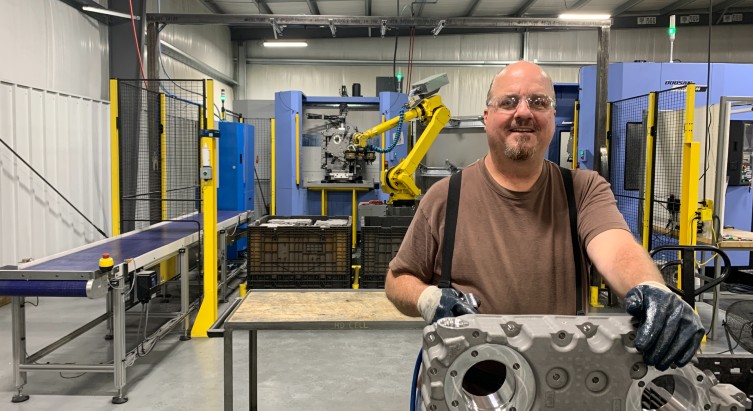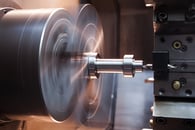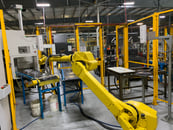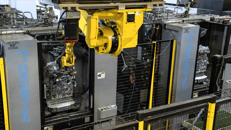Automation is here to stay.
While the overall labor shortage is forcing the hand of manufacturers that haven’t yet embraced automation, those that know it consider automation to be a manufacturing advantage.
Previously, we shared “Tips for Using Industrial Robotics in a CNC Machine Shop,” which covered various aspects of using robotics: robot functions, programming, and the best ways that a shop can use robots.
Of course, some people view robots as a threat instead of a benefit. Are machines stealing a job from a human? Will they eventually perform all manufacturing tasks? Let’s answer those and explore how automation is best used, specifically within a CNC machine shop, and how it differs from shop to shop.
What are the 2 Main Advantages of Using State-of-the-Art Technology?
- Increase capacity — With the manufacturing world now bouncing back from the pandemic, more and more companies have reshored their resources, putting extra strain on U.S. manufacturers. That stress on capacity is being felt in every corner of every industry.
Automation, including robotics, usually increases capacity. Increased throughput is never a bad thing, especially with today’s labor market challenges, and it helps reduce the strain on the shop’s human resources department, which is desperately searching for qualified workers in a nearly tapped out worker marketplace.
Being able to produce beyond what could be done before, CNC machining professionals are using automation to set the table for long-term success.
- Boost productivity — A robot that performs a task exactly the same every time provides incredible advantages: it’s accurate/precise, it’s repeatable, and the machine doesn’t take a break, so it’s productive. Many robots, such as the FANUC M-series, are designed and built for manufacturing environments and, with prescribed preventative maintenance, these robots are durable. You can depend on it to perform without manual input or interruption.
The result? Improved quality: the most important indicator of a CNC machine shop’s worth in customers’ eyes.
Is Automation Right for Every Shop?
One exercise that not enough CNC shops do is to audit their existing workcells to see if automation would be a good fit. Could this part be manufactured better or quicker or cheaper if automation were introduced?
When a workcell is operating at its limit is the best time for an audit. A full assessment, from cycle times to all manual operations required, can uncover opportunities previously unseen and determine if automation is a smart upgrade. Gaining even a small edge each shift adds up to significant advantages over a year’s time.
Automation can't be introduced to every workcell on the shop floor, so care must be taken to introduce it wisely.
CNC Manufacturing Robotics: A Worker’s Best Friend
People should be responsible for a shop’s most important tasks, which doesn’t include heavy manual labor. People who used to do the “heavy lifting” are now performing more valuable duties: measuring outputs and making manufacturing processes adjustments. This change in roles (especially reducing physically demanding tasks) is welcomed at CNC shops. It means better parts for customers and better days for shop workers.
Careers are now extended; not only because of the reduced physical tolls but also to gain knowledge about robotics with on-the-job training/learning. Programming adjustments are needed as well as the ability to troubleshoot on the fly and change how the robot operates. As skills are developed, more opportunities are available for current workers to take on new automation projects, in leadership and/or training.
Safety First. Safety Always.
Like nearly any machine, a CNC manufacturing robot has the slight potential of harming an individual. Yet, with simple and proven safety measures in place, workers are well protected from any risk.
Two particular safety initiatives protect human workers from any potentially hazardous situations involving robotics:
Light curtains — Anything that breaks the plane of an invisible light curtain immediately shuts down the robot. This prevents people from getting too close to a robot running in auto-mode. When something breaks the light curtain the robot automatically stops to prevent any potential collisions.
Fencing — Physical fencing makes it nearly impossible to approach an active robot. Fencing and light curtains work together to limit access to a running robot.
When an operator needs to make a robot adjustment, the robot mode is changed from “automatic” to “teach,” reducing the robot’s speed and engaging a teach pendant, putting the operator in full control of the robot.
Long before any equipment is bolted to the floor, a detailed plan ensures that any operator interaction with a robot will be done safely.
Collaboration, Setup, and Operation
CNC machine shops don’t purchase robotics, set them up themselves, and push the start button. Third-party companies — automation integrators — that specialize in industrial robotics work with the shop’s team to concept, plan, design, and install a workcell with CNC manufacturing robotics.
These experts in automating manufacturing workcells develop detailed working knowledge of the shop, its goals, and even culture to ensure the right robotics are doing the right work.
Asking the right questions early helps determine the best setup:
- What parts need to be machined?
- What are the target production numbers?
- What machines are available?
- What is the fixture concept?
- What are the steps in the manufacturing process?
- Are people currently machining the parts?
- And many more
Only after exhaustive research will the automation integrators order the robots for the shop, which then get installed with help from the shop’s automation team. Programming, testing, and training finish up the process before full production launches.
And, just like any manufacturing workcell, bumps in the road require smoothing to fine-tune the process for maximum efficiency. These experiences teach the machine shop team during every installation, preparing them for the next automation opportunity.
Meeting Future Customer Demands Starts Today
Investing in advanced technology can be intimidating, yet it’s the bold machine shops that pull the trigger and set themselves apart from others in order to meet customer needs.
Robots aren’t cheap, so when is investing in automation a justifiable expense? It mostly comes down to the volume of the parts requiring machining. An order of 10,000 parts taking over 5,000 spindle hours per year, for example, is a solid commitment that makes the decision easy. Smaller numbers need to be evaluated to determine the best plan. Yet, even with the help of automation, highly skilled people are required to fulfill any order.
The daily, connected effort of people and robots makes automation an exciting and necessary aspect of CNC machine shop success today and moving forward. Clean environments, smooth-running facilities, and advanced technologies create a shop floor that’s stimulating to work in each day.
Success working with CNC manufacturing robotics can be predicted by a shop’s day-to-day processes. Stecker Machine was recently recognized for its shopfloor practices and performance by the editors of Modern Machine Shop. Now a “2022 Top Shop,” Stecker ranks in the top 20% of scores in four categories: technology, shop practices, strategy, and human resources.
As we covered, one benefit of automation is efficiency. If you’re wondering how a machine shop can be dedicated to Lean manufacturing, check out our eBook. Just click the link below to get your copy of The Benefits of Lean Manufacturing in Machine Shops.







